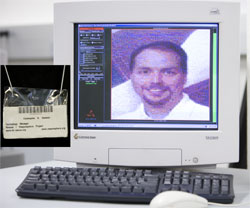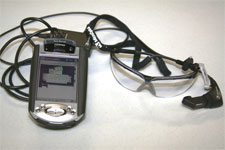UCI Campus Serves as Test Bed for New Technologies
By Anna Lynn Spitzer
|
Oct. 30, 2006 – To the casual observer, the fourth floor project room in UCI’s Calit2 Building appears to be a high-tech playground, filled with state-of-the-art toys.
Mobile cameras instrumented with 802.11 interfaces, RFID tags and readers, sensor-equipped miniature cars and human-as-sensor contraptions known as Evac-Paks are just a few of the technologically advanced gadgets researchers are toying with.
But ResponSphere, as this ResCUE component is more formally called, is not just fun and games. It is actually “a proving ground for disruptive technology,” according to Technology Manager Chris Davison. Disruptive technology is a new technological innovation, product or service that will eventually overturn existing technology in the market. The “toys” are prototypes developed, tested and refined to aid first responders in crisis situations.
To see how their products perform, researchers have turned a large part of the UCI campus into a living test bed called CAMAS, which they use for emergency drills. Known as “smart areas,” these designated spaces have been equipped with wired and wireless networks, cameras, a variety of sensors – acoustic, video, temperature, humidity, light, accelerometers and people counters – and innovative software to interpret the collected data.
|
||||
CAMAS’s networked space currently includes the Calit2, Engineering, ICS and Engineering Gateway buildings, as well as a section of Ring Road. This fall, work is underway to add the Administration Building, Gateway Study Center, Student Services and – when it’s completed – the new Student Center.
Davison and a complement of undergrad and graduate students design, build and/or monitor technology prototypes that are tested in CAMAS. These potentially life-saving innovations are developed for use in current and/or future ResCUE products, and include:
- Mobile Autonomous Sensing Platforms. These “model cars,” which have been built in three successively larger sizes, can be sent by remote control into danger zones to assess the situation. The larger versions are equipped with audio, video and gas sensors, as well as an accelerometer, thermometer and onboard computer that can stream data back to the software systems. The smaller versions carry some of those features.
|
- Mobile cameras. Equipped with 802.11 wireless network interfaces, these Linksys tilt-pan-zoom cameras can be dropped into dangerous areas; custom software allows them to automatically send back location-specific coordinates along with images.
- People Counters. Using low-power lasers and installed at each “smart building” entrance, these devices work in conjunction with mounted cameras to track the number of occupants coming and going.
- Evac-Pack . (http://www.calit2.net/newsroom/article.php?id=966)
- Location-Based Sensing Technology. These products include Radio Frequency Identification (RFID) tags and readers that enable location-awareness, video people-counting equipment, GPS and other sensor platforms that are utilized for tracking the whereabouts of building occupants and first-responders.
Live emergency drills cause major disruptions, so they’re only held a few times each year. The CAMAS system is also able to conduct and analyze simulated drills in the smart spaces, using a ResCUE-developed augmented-reality platform called DrillSim. These computer-based simulations factor in past experience and pre-programmed behavior, including decision-making behaviors.
“The idea is that we can’t empty out whole buildings every time we want to run a test, but we can test a piece of technology whenever we want in a simulation,” Davison says.
Corporate, academic and government partners can also test their prototypes in the test bed, either in live drills or simulations.
Data from all drills is kept and cataloged. Building maps, sensor data, response times, temperatures, and audio and video footage from drills are just some of the data that will be available to future researchers when ResCUE’s five-year run is completed.
“ResponSphere provides a platform where we and our many industry partners can test new software and hardware technologies,” says Davison. “Thanks to all of this data we’re keeping, ResponSphere will live on past its life cycle. That will be our legacy when we’re done here.”
Related Projects
Responding to Crises and Unexpected Events
ResponSphere





